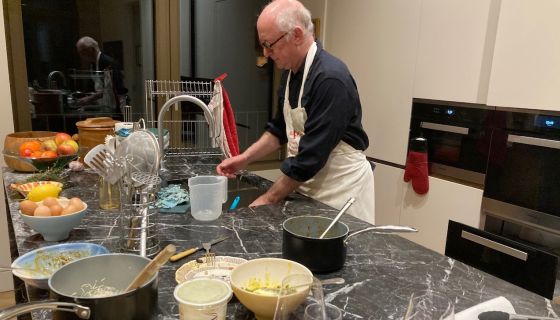As chief cook and bottle washer in our house for the past 40 years, I have long come to appreciate that my tasks do not come to an end when everybody else has left the table. There is the clearing up to do.
Over the past year, when there has been rarely more than Jancis and me at the table, I have found myself repeating the same phrases. After lunch it is an injunction to her to return to her website (her ‘fourth child’, as our three physical children have long referred to it). After dinner during lockdown, it is with the instruction that she should find something for us to watch.
Left alone, my mind starts to wander. Back to restaurants and from there to the far more numerous tasks that face any professional team at the end of every evening.
Here, there is a non-negotiable professional standard at stake: that the kitchen and front-of-house staff want to leave the restaurant as clean as possible so that those who come in the following morning will leave it equally clean for them. Kitchen staff usually work a week of lunch shifts followed by a week of night shifts so there is always an opposite number to hand over to, to try and impress. Today, on top of professional pride, there are the extra cleaning responsibilities required by COVID-19 (when restaurants are open, of course).
And while the chores at the end of the evening seem obvious and repetitive for the kitchen staff – to clean the section where you have been working, its walls and the inside of the ventilation hood – these have grown more numerous and fiddly for the waiting staff.
As chefs’ imaginations have grown, so have the demands that they have put on their waiters’ duties. Tasting menus have become more complex. There are often plates of salted and unsalted butter. There are plates of pre-desserts, desserts and petits fours. And the main course will invariably be served on an intricate and expensive plate alongside an equally expensive knife, items which, necessarily and obviously, need to be accounted for at the end of every evening.
Such items all too often ‘develop legs’. I can still recall an ashtray with a spindle in its centre which allowed the ash to drop out of sight. I bought three dozen for my restaurant when it opened. My far more savvy restaurant manager commented, ‘I’ll give them three weeks before they’ve all gone’. She was absolutely right.
Today, all top restaurants will have a ‘closing down’ document that lists all the duties and actions that their staff have to fulfil before the restaurant can finally be closed for the night.
To get some idea of what is involved I turned to Johnny Smith who opened The Clove Club with chef Isaac McHale in the former Shoreditch Town Hall in 2013. The Clove Club has a formal-looking document called the FOH Close Down Checklist with the date and the days of the week across the top. More ominously it goes on to say, ‘No one is to sign off for the evening until the checklist has been signed off by the manager on duty’.
It then lists 72 separate items which the waiting staff must fulfil before they head home, items which are broken down into seven distinct headings: 18 relate to the dining room, 13 to cheese and bread, 4 to linen, 11 to the restaurant’s particular front room and bar, 5 to bathrooms, 3 specifically to the kitchen porters’ area, 8 to outside, and the last 10 refer to a ‘final check’ that is presumably the responsibility of the general manager on duty on the night.
Within each heading there are certain items that stand out. Firstly, in the dining room section, there is the instruction to ‘count the number of sharp knives and enter number’. These knives, the result of a cooperation between McHale and a knife designer, cost £80 each. Then there are the very specific instructions that the dining-room chairs are to be stacked three high, after wiping, and that the floor must be hoovered – ‘and NOT JUST THE CARPET’.
It takes a team of five or six about an hour to fulfil the entire list. The tasks vary from storing the breadcrumber in its correct position to setting up for the staff breakfast on Table 29. Then there follows the instructions for the outside area, which include bringing in the cigarette bin and cleaning it, and ‘having a look for rubbish in the flower pots’.
Smith continued: ‘the end of service, although it is primarily composed of repetitive tasks, is really important for camaraderie. I happily remember as a young waiter at Croma in Manchester bidding farewell to our guests before having a beer and a laugh with my colleagues while counting the linen or cleaning the coffee machine.’
And on checking with one of his head waiters, Anastasia Knowles, he discovered an unusual quirk or two. She endearingly described how she loves cleaning the tables with hot and very soapy water then drawing quick pictures in the soap before wiping them dry. She also admitted that she found bin duty oddly satisfying.
To be a good waiter requires many varied skills: a good sense of humour, energy, a pair of eyes that observe everything, and a willingness to please. These attributes and more, when restaurants are open, are tested again in the early hours of the morning.
These are attributes which I will now ponder as I clear up my solitary table for two.













